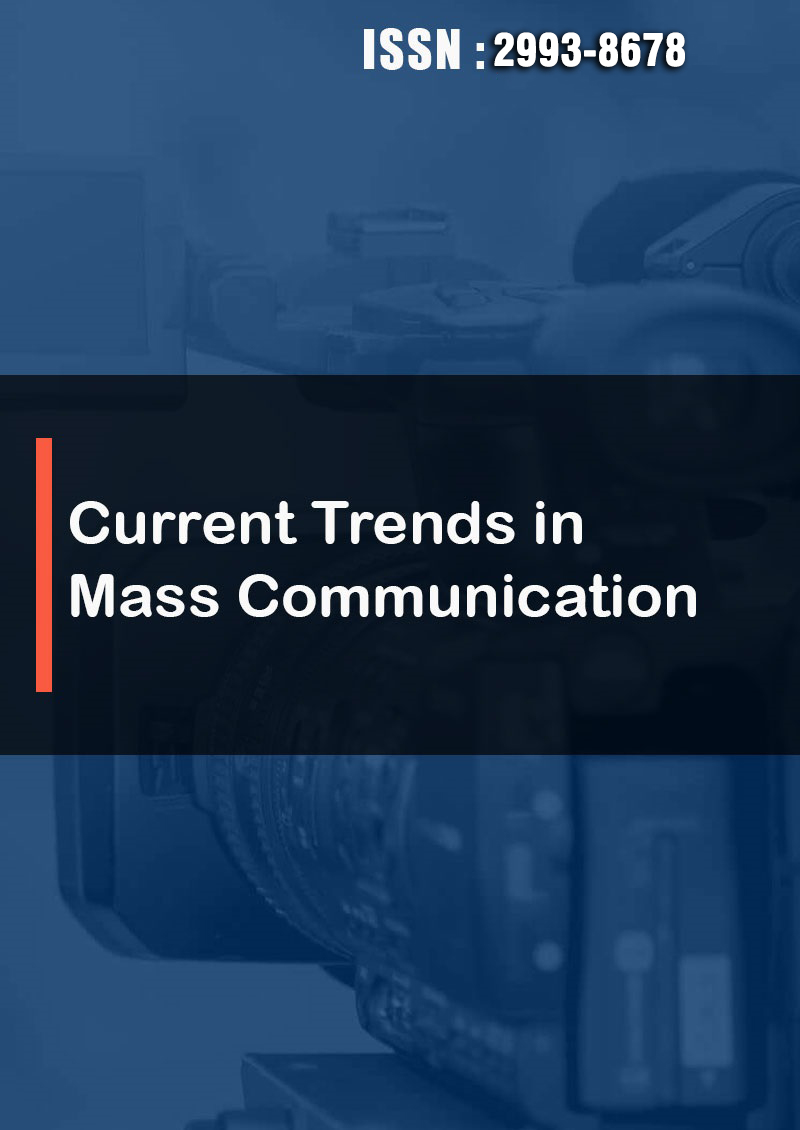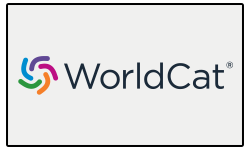Research Article - (2025) Volume 4, Issue 1
Awareness, Perception and use of Internet of Things Amongst Advertising Practitioners in Lagos, Nigeria
2Lecturer, Department of Mass Communication, Mountain Top University, Ogun State, USA
3Senior Lecturer, Department of Mass Communication, Dominican University, Ibadan, USA
Received Date: Mar 02, 2025 / Accepted Date: Apr 14, 2025 / Published Date: Apr 23, 2025
Copyright: ©2025 Njoku Chioma, et al. This is an open-access article distributed under the terms of the Creative Commons Attribution License, which permits unrestricted use, distribution, and reproduction in any medium, provided the original author and source are credited.
Citation: Chukwubuikem, A. M., Chioma, N., Ebenezer, O. I. (2025). Awareness, Perception and use of Internet of Things Amongst Advertising Practitioners in Lagos, Nigeria. Curr Trends Mass Comm, 4(1), 01-12.
Abstract
The introduction of new technologies has revolutionaries human activities and this has drastically changed the way we do things. In an attempt to provide the basis to underscore the above statement in advertising business, this study investigated the awareness, perception and use of Internet of Things among advertising practitioners in Lagos. The following objectives guided the study: to ascertain the level of awareness of Internet of Things among advertising practitioners; to find out their perception of Internet of Things and to determine the frequency of usage of Internet of Things among advertising practitioners in Lagos. The technology determinism theory and the uses and gratifications theory were the theoretical foundations upon which this study was anchored. The descriptive survey was the research design used in the study to gather data from 122 respondents with the questionnaire as the instrument for the study. The data collected were analyzed using descriptive statistics and chi-square cross-tabulation with a focus on the Pearson Chi-square Cramer’s V (as P value) which is set at 0.05 levels of significance. The findings from the study revealed that most of the male respondents between the ages of 26 – 35 years who were currently in their tertiary level of education are aware of the Internet of Things. Further findings revealed that there was high level of positive perception and assessment of the technology while the frequency of usage of the Internet of Things was found more among respondents between the ages of 25 – 35 years. The findings from the hypothesis result corroborated this as demographic variables were found not to significantly affect awareness and frequency of usage of Internet of Things. However, the researcher believes that other variables like one’s need of a technology and its ease of use (as found in literature) can affect how often one uses a given technology.
Keywords
Advertising, Internet of Things, Connectivity and Business
Introduction
Internet of Things (IoT) as a concept has changed the way we do things and has reduced the complexity associated with human life to an easy and convenient life void of stress. The concept of Internet of Things was first popularized in 1999. According to Vermesan and Friess “it is simply a network of interconnected devices” [1]. Abashidze and Dabrowski (2016) added that the word “device” refers to: “Computers, smartphones, vehicles, house equipment, manufacturing devices, medical implants, even entire buildings and the list can be much longer.” The idea behind the concept of Internet of Things is exchange of data through the interconnections enabled between devise in such a way that the owner of such devices gains a wide range of benefits. Online advertising is not left out of the benefits accruing from the introduction of the concept of Internet of Things. Content creators in advertising can now provide their usual services to consumers for free to end users and yet monetize it. According to Aksu, Online advertising allows web content creators and services providers to monetize yet providing their business free to end users. For example, news websites or search engines can operate without charging users as they get paid by advertisers who compete for buying dedicated slots on those web pages to display ads. Also, with the use of Internet of Things technology, one can monitor the number of items removed from his refrigerator on daily basis and get information via a linked device (possibly his smartphone) on what items need to be replaced in the refrigerator.
<img src="https://www.opastpublishers.com/scholarly-images/9049-681838ec38650-awareness-perception-and-use-of-internet-of-things-amongst-a.png" style="width:650px;height:400px;">
Research has shown that Internet of Things are good tools for communication with consumers and product and service promotion. It is the future of advertising and marketing in the digital era especially as it concerns online advertising. The variety of opportunities that are open to be explored in the Internet of Things technology makes it a trending technology to be employed as it bridges the gap between time and space in online advertising in the digital era. Many marketers and advertisers consider the Internet of Things as a future of marketing and advertising rather than something that is already actively in use today. Practical development is way more advanced than its theoretical basis in the area of Internet of Things and internet marketing as a whole. According to Akutota and Bhargava, “the following technologies are to be implemented in order to maximize the use of Internet of Things in advertising business as a personalized advertising technology:
Beacon
Beacon is a device, which allows Mobile Apps to listen for signals from beacons in the physical world and react accordingly. In short, Beacon technology allows Mobile Apps to understand their position on a micro-local scale, and deliver hyper-contextual content to users based on location. The underlying communication technology is Bluetooth Low Energy.
Dash Button
Dash physical instant purchase buttons are one-push buttons for buying everyday items. They are directly linked to the store and can place on order with just one push. This makes buying everyday necessities a convenience.They are installed in homes, especially for objects that people need the most.
Smart Environmental Variable Control
A smart environment can be defined as one that is able to change the levels of the variables based on the data that is read from sensors. A smart environment system automatically controls the devices according to the sensing information and users' requirements so as to keep the environmental elements such as temperature, humidity, etc. within the desired range.
RFID
Radio Frequency Identification (RFID) technology is a non- contact, automatic identification technology that uses radio signals to identify, track, sort and detect a variety of objects including people, vehicles, goods and assets without the need for direct contact RFID technology can track the movements of objects through a network of radio-enabled scanning devices over a distance of several meters.
Statement of the Problem
The competitive nature of the advertising industry makes the search for new technologies a growing trend because of the need to stay ahead in the advertising business. The world is heading towards a rapidly changing scenario where shopping mall experiences become more automated and cloud-centric; where people can easily place order for products or services with just one push of a button as a result of huge amount of data that can be personalized or made to suit one’s advertising needs. All these efforts are geared towards meeting the global trend in advertising especially as it concerns digital internet advertising.
In the wake of this growing scenario, this study seeks to investigate: the extent advertising practitioners know about Internet of Things technology and what they make out of it by way of perception as well as their personal experiences with using such technology especially in the advertising business.
Research Objectives
This study investigates advertising practitioners’ awareness, perception and use of internet of things in advertising business. More specifically, the study objectives include:
• To ascertain the level of awareness of Internet of Things among advertising practitioners in Lagos.
• To find out their perception of Internet of Things in advertising business.
• To determine the frequency of usage of Internet of Things among advertising practitioners in advertising business.
Literature Review
Okorie Digital Marketing in the Age of IoT: A Review of Trends and Impacts
This paper provides an in-depth review of digital marketing in the context of the Internet of Things (IoT). As IoT technology integrates into daily life, its impact on marketing strategies and consumer engagement is significant. The review aims to outline how IoT is transforming digital marketing practices. Using a systematic approach, the paper analyzes existing literature and case studies to uncover key trends in IoT-driven marketing. It finds that IoT allows marketers to collect real-time data, facilitating more personalized and context-aware strategies. IoT devices like smart home appliances, wearables, and connected vehicles are emerging as new digital marketing channels, enabling direct and interactive consumer engagement. The paper also addresses challenges and ethical concerns, such as privacy and data security, emphasizing the need for strong regulatory measures. Overall, IoT is enhancing digital marketing by making it more dynamic and personalized, altering the brand-consumer relationship. The paper concludes with suggestions for future research and practical advice for marketers to effectively use IoT in their strategies [2].
Blending Internet-of-Things (IoT) Solutions into Relationship Marketing Strategies
The paper explores how the Internet-of-Things (IoT) is becoming integral to modern business strategies due to its rapid technological advancements and increased accessibility. IoT allows physical devices to connect and exchange data, offering companies opportunities to enhance efficiency and responsiveness. The study investigates how companies incorporate IoT into their relationship marketing strategies to improve performance and navigate technological disruptions. Using in-depth case studies from Taiwan's IoT industry, the research examines insights from highlevel managers gathered through interviews and observations. It emphasizes the need for companies to align their marketing strategies with technological trends to stay competitive and profitable. Key findings highlight the importance of understanding IoT’s impact on client behavior and strategy development. The research shows that IoT can strengthen relationship marketing by fostering longer, more successful client relationships. However, concerns over data security and trust vary by business segment and marketing principles. The study contributes to literature by linking IoT with relationship marketing, demonstrating how their integration can enhance marketing strategies and business outcomes. It also suggests the need for further research to explore these dynamics in greater depth as technology continues to evolve [3].
The Internet of Things (IoT): What is the Potential of Internet of Things Applications for Consumer Marketing?
This paper explores the Internet of Things (IoT) from a consumer marketing standpoint, focusing on its marketing implications, opportunities, and associated risks. The review of existing literature suggests that IoT could generate up to $11.1 trillion by 2025, though privacy and security issues remain. Based on popularity, the paper categorizes IoT into five application domains—Personal, Smart Environment, Home, Vehicle, and Retail. To assess their marketing value, it analyzes real-life examples from each domain, such as LiveSkin, Placemeter, Amazon Dash, Tesla Model S, and Smart Retail Solution. The findings indicate that the marketing value of these applications does not necessarily align with their popularity rankings [4].
The Convergence of Mass Communication and Internet of Things (IoT): Opportunities, Challenges, and Implications
The Internet of Things (IoT) is bringing about unprecedented potential and difficulties as it integrates with public communication, continuing to change numerous sectors. This study examines how mass communication and the Internet of Things are convergent, looking into its consequences for business, society, and communication methods. Employing an extensive this research seeks to shed light on current developments through analysis of case studies, and theoretical frameworks, and shedding light on the convergence's revolutionary potential while addressing privacy, ethics, and worries about security. By looking at how IoT can improve media accessibility.
This study provides insights into how IoT-enabled personalized and interactive delivery of content and audience interaction are altered by communication devices. Additionally, it explores the effects on media of IoT-driven data collection and analysis groups, sponsors, and decision-makers. To measure mass media consumers', Internet of Things device users', and the general public's perspectives, attitudes, and actions regarding privacy, trust, and willingness to share data, a survey was created. Descriptive statistics and regression modeling were used in the survey analysis to determine the variables impacting respondents' attitudes toward the convergence of the Internet of Things and mass media. The report addresses privacy, security, and possible mass surveillance concerns with the positives and drawbacks of this convergence, including tailored content distribution and targeted advertising.
Improved user experiences are made possible by the integration of IoT into mass media, but there is also an increased risk of data exploitation. To maximize benefits and minimize hazards, a comprehensive strategy incorporating technological, social, ethical, and regulatory issues is required [5].
Potentials of Internet of Things for Effective Public Relations Activities: Are Professionals Ready?
The study explored the potential of the Internet of Things (IoT) in public relations (PR), coining the term "Smart-PR" for its application. The literature review covered the history and current use of IoT and its integration into PR, highlighting benefits such as access to consumer data, improved decision-making, anticipation of customer needs, and multi-channel communication. An online survey, conducted from November 2018 to April 2019, targeted Nigerian PR professionals through the Nigerian Institute of Public Relations (NIPR), the Public Relations Consultants Association of Nigeria (PRCAN), and social media. The survey aimed to gauge the perceptions of these professionals toward IoT in PR. Respondents were categorized into two groups: those from independent PR firms and those from internal PR departments within larger organizations. The study anticipated different experiences between these groups, given the distinct pressures and focuses of their work environments. Out of the responses, only 100 surveys were correctly completed and analyzed. The analysis revealed that independent PR firms were more likely to adopt IoT technologies than internal PR departments. The study concluded by recommending that PR professionals explore IoT's advantages for enhancing their practices. Additionally, feedback suggested a preference among some professionals for hard-copy surveys over online versions, indicating varying levels of internet comfort [6].
Enabling mass surveillance: Data aggregation in the age of big data and the Internet of Things
The concept of the Internet of Things, which refers to a networked, interdependent, and interoperable world, entails inherent risks. One of these risks is the reality that it makes it easier to continuously monitor populations. This variation of the ability to monitor is enabled by IoT devices, which capture and convey enormous volumes of shared data and are examined in novel and distinctive ways to facilitate the widespread surveillance of persons. In the end, the information gathered by the A level of surveillance was previously only possible because of the Internet of Things discussed in books of science fiction. This piece looks at the repercussions for the privacy of this "new norm" of constant surveillance, The main function of the business sector in supporting and participating in this monitoring, and what can be done about it [7].
The architecture of mass customization-social internet of things system
In the era of big data, mass customization (MC) systems grapple with the complexities arising from an explosion of information and the need for stringent management control. To address these challenges, integrating the mass customization system with the Social Internet of Things (SIOT) has become essential, facilitating a seamless connection between customers and enterprises. This integration not only allows customers to actively participate in the MC production process but also enables enterprises to maintain control over all aspects of the information system. To elucidate this concept, the paper initially outlines the architecture of the proposed system from both organizational and technological viewpoints. It then delves into the primary technological applications of the mass customization–Social Internet of Things (MC–SIOT) system, based on the characteristics of the SIOT. Following this, the paper enumerates the key challenges faced by the MC–SIOT system. The findings highlight several capabilities of the MC– SIOT system: (1) it facilitates easy access to information and a clear understanding of user intentions; (2) it can forecast changing relationships across different technical domains, aiding enterprise R&D personnel in locating relevant technical knowledge; and (3) it integrates deep learning and digital twin technologies to enhance system operational maintenance. Nonetheless, the system faces challenges related to data management, knowledge discovery, and human–computer interaction, including issues like data quality management, limited data samples, insufficient dynamic learning, labor consumption, and task scheduling. To address these issues, the paper proposes possible improvements and suggests that privacy issues and emotional interactions should be further explored in future research. Finally, the paper illustrates the behavior and evolutionary mechanisms of this system both qualitatively and quantitatively, offering insights into how to tackle current challenges associated with mass customization systems [8].
Internet of things: Emerging impacts on digital reporting. The paper outlines a future research agenda aimed at reviving interest in digital reporting through the advent of the Internet of Things (IoT). Utilizing frameworks from media richness and corporate communication, the authors investigate the evolving stages of digital reporting and review existing academic literature on IoT to explore opportunities and practical concerns for advancing the digitization of accounting information. The analysis examines how IoT's media richness-related features influence the dynamics of corporate communication, including aspects like communicator, message, medium/channel, audience, relationship, and conversation. An integrative review approach was used to examine the role of IoT in corporate reporting. This approach involves reviewing, critiquing, and synthesizing representative literature to generate new frameworks and perspectives. The paper is divided into sections that deconstruct IoT into basic elements based on two conceptual models. The first section focuses on IoT features in terms of media richness, while the second section discusses the impact of IoT on elements of corporate communication. The study concludes that IoT has the potential to enhance, rather than hinder, existing digital media solutions by facilitating real-time and multi-dialogue interactions in corporate communication. This integration of IoT into digital reporting systems offers new possibilities for richer, more dynamic corporate communication [9].
Opportunistic IoT: Exploring the social side of the Internet of Things
The Internet of Things (IoT) is regarded as a technological revolution that will shape communications and computers in the future. Its objective is of a next-generation Internet that makes it easier for people, society, and smart gadgets to engage harmoniously. The technical facets of connecting and controlling devices are the main focus of current Internet of Things research. The social and human-centric aspects of IoT, however, are still little understood. The goal of this post is to introduce IoT from a human-centric standpoint. The authors introduce the idea of Opportunistic IoT by examining the intimately linked relationship between people and the opportunistic connections of smart devices (such as smartphones and cars). Through human mobility and chance encounters, opportunistic communities are formed. This approach facilitates information sharing and dissemination inside and among these communities.
The paper examines novel application domains, highlights the difficulties posed by this new computing paradigm, and analyzes the reciprocal interaction between humans and opportunistic IoT [10].
The combination of Internet of Things technology based on probability model network and mass education
As the Internet of Things continues to grow, educational informatization has become a major area of interest for educational applications. The attainment of instructional objectives and assistance is improved by the integration of Internet of Things technology with diverse educational sectors. Weight distribution in the multimodal teaching optimization model poses a challenging multiobjective decision-making problem. To calculate complete weights, this research suggests a Bayesian network based on a probability model paired with the big entropy criteria. The best use of sample data and domain knowledge is made possible by the combination of Bayesian statistics and Bayesian networks. Dependencies between variables are represented by arcs in Bayesian networks, and the degree of these dependencies is shown by probability distribution tables. Bayesian networks enable the merging of previous knowledge and data by combining sample knowledge with prior information. This works especially well in situations when sample data is difficult to get or scarce. To connect objective characteristics and influencing elements to self learn target weights, a Bayesian network is utilized. This study aims to investigate the internal relationship between information technology and university citizenship curriculum by gaining a deeper understanding of both. This will promote deeper integration and improve the efficacy of teaching university citizenship curricula. This integrated strategy so fosters the progress of education [11].
Review of Internet of Things (IoT) for Future Generation Wireless Communications
The creation of efficient, wireless, small devices was made possible by technical breakthroughs, which gave rise to the Internet of Things (IoT). This study looks at IoT's involvement in a variety of industries, analyzes technological obstacles, and looks at the opportunities it presents. The future of human life depends more and more on IoT and 5G as they turn things into intelligent machines. The study offers a thorough analysis of 5G and IoT technologies, emphasizing how they could change how people view the digital world. The industrial Internet of things (IIoT) requires high reliability, low latency, flexibility, and security in its communication protocols. These criteria are successfully satisfied by 5G mobile technology, which makes it a strong contender for IIoT situations. The study also discusses the difficulties that exist now in IoT research and looks into possible fixes for 5G-enabled industrial IoT [12].
Communication About Sensors and Communication Through Sensors: Localizing the Internet of Things in Rural Communities
Sensor networks connected to the Internet of Things (IoT) are a new technology that is essential to the ratification and optimization of large-scale environmental infrastructures, from "smart cities" to more efficient workplaces. Particularly well-suited for local installations in rural communities—which are sometimes disregarded by digital development initiatives—is this low cost, low-power technology. A social construction of technology approach was used to investigate how different Internet of Things stakeholders in the United States, such as designers, advocates, and citizen stakeholders, perceive and comprehend sensor network technologies. The goal of the study was to develop sensor networks in partnership with rural community residents using observational methodologies, in-depth interviews, and participatory design research in an Upstate New York rural municipality. The intention was to produce information that would improve local knowledge and assist the community. The results showed that to provide safe, moral, and localized sensing in these communities, creating sensor networks for rural areas requires overcoming communication related obstacles both about and through sensors [13].
Internet of things applications: From research and innovation to market deployment
The book provides a comprehensive overview of the Internet of Things (IoT), covering topics from research and innovation to enabling technologies, nano electronics, cyber-physical systems, and industrial applications. It serves as a standalone volume in a series focusing on the activities of the Internet of Things European Research Cluster (IERC), highlighting technology advancements, international cooperation, and the global state of IoT. The book draws from the Strategic Research Agenda of the IERC and offers a global perspective on the challenges and advancements in IoT research, development, and deployment. IoT is presented as a transformative paradigm with potential applications across various industries, including healthcare, pharmaceuticals, agriculture, telecommunications, automotive, and more. It will benefit semiconductor companies, device manufacturers, infrastructure and application software firms, and other stakeholders by generating new revenues and driving market competition. The IoT's success hinges on advancements in enabling technologies, market acceptance, and standardization, which ensure interoperability, reliability, and global operations. Connected devices form ecosystems that integrate people, processes, data, and things through cloud computing, necessitating standardized communication and metadata. Security, privacy, safety, and trust must be addressed throughout the product lifecycle. The book addresses the full spectrum of IoT, from edge devices to cloud data centers, and emphasizes the creation of ecosystems by industry, research, and application stakeholders. It highlights how enabling technologies such as nanoelectronics, sensors, cyber-physical systems, and smart infrastructure will foster new products, services, and smart environments, including smart cities, transport, buildings, and healthcare [9].
The study used the technological determinism theory and the uses and gratifications theory. The former according to Marshal McLuhan is premised upon the dictum: “The medium is the massage”. He further asserts that the content of any particular medium has as much importance as the stenciling on the casing of an atomic bomb. Relating this within the context of the study Internet of Things as an emerging technology has nothing to do with opinion or concept of the audience but rather alters them by massaging the opinion of the audience without their resistance On the other hand, the Uses and Gratifications theory according to Folarin perceives the recipient as actively influencing the effect process since he selectively chooses, attends to, perceives and retains the messages from the devices used by the Internet of Things technology [10]. According to Griffin “the media can have little or no impact on persons who have no use for them” [11]. Here, consumers are seen as active gratification seekers who by interacting with the media content gets their needs met. But in the case of Internet of Things technology, while these needs are met, certain data or information from the consumer are retrieved and shared without the consent or knowledge of the consumer.
Methodology
This survey adopts quantitative approach to assess awareness, perception and usage of Internet of Things among advertising practitioners in Lagos. Hence, questionnaire was used as the measuring instrument to elicit responses from 148 advertising practitioners in Lagos. The questionnaire contains two sections. The section A contains demographic data on the respondents based on sex, age, educational qualification and specialization. The section B contains information on the subject under study. The section B is designed in a manner that ensured that only relevant questions that addressed all the research questions were accommodated. Snowball sampling technique was adopted to ensure that only recognized advertising professionals that practice in Lagos participated in the study. The researchers engaged four (04) advertising practitioners who were members of the Advertising Regulatory Council of Nigeria (ARCON) for the distribution of the measuring instrument. They only had to drop the instrument on Whatsapp and other official social media platforms of ARCON, Lagos chapter and encouraged members to fill the questionnaire.
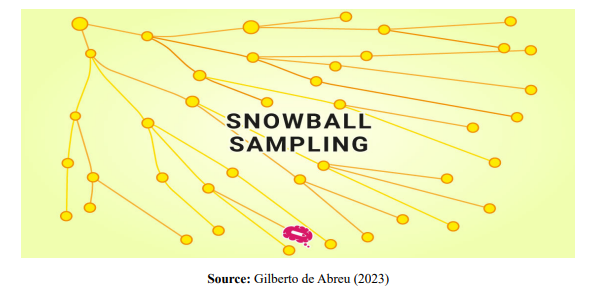
Result and Discussion
In this section, the results from the data analysis on respondents’ awareness, perception and use of Internet of Things are presented Results and Discussions in charts while the hypotheses results are presented in tables showing the level of significance (at 0.05 levels of significance) for the P value.
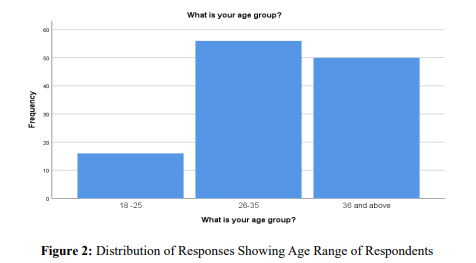
The result in figure 1 above shows that out of the 122 respondents in this study, 56 of them fall within the age range of 26 – 35 years and they ranked highest. This is followed by respondents between the ages of 36 years and above recording (50 out of 122), leaving respondents between 18 – 25 years at the bottom of the chart with 16 (out of 122 respondents). The implication of this result is that most of the responses in this study will be attributed to young individuals who research has shown to be internet savvy. This can serve as a basis for generalization within the study group or among people of the age range used in the study.
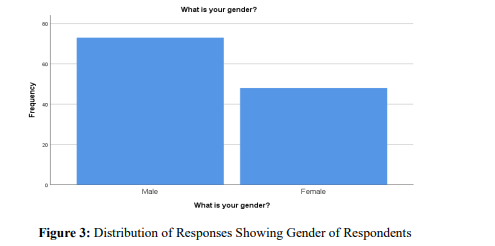
From the result in figure 2 above, majority of the respondents 73 (out of 122) are males, thus they ranked highest under the distribution of responses according to gender while their female counterpart ranked second with 49 (out of 122) respondents. The
implication of this result is that most responses from this study will be attributed to the behavior and attitudes of the male gender and it is believed that they are likely to be more internet savvy than the female gender.
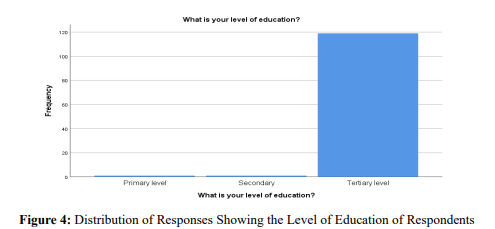
Results emanating from figure 3 above revealed that most of the respondents (119 out of 122) are in tertiary level of education and they ranked highest under the distribution of responses according to the level of education of respondents. On the other hand, respondents in their Secondary and Primary levels of Education were left at the bottom of the chart with 1 each (out of 122) respondents. The implication of this result is that most responses
from this study on the use of Internet of Things by the study units will be attributed to individuals in their tertiary level of education and they are believed to be more exposed to online advertising that requires the use of Internet of Things. This will make their response relevant and useful towards achieving the objectives of the study and can serve as a basis for generalization.
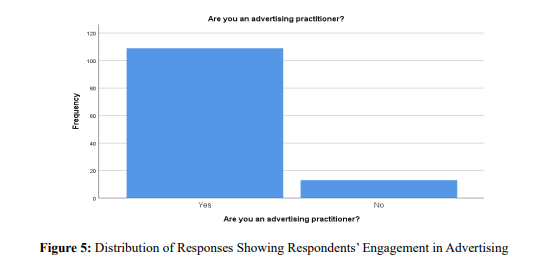
The result in figure 4 above shows the number of respondents that are engaged in advertising as practitioners. Findings from the result revealed that majority of the respondents 109 (out of 122) Figure 5: Distribution of responses showing how long respondents have been practicing advertising are Advertising Practitioners as against a few respondents (13 out of 122) who are not Advertising Practitioners.What this means is that most responses emanating from this study on awareness, perception and use of Internet of Things in Advertising Business will be attributed to active players in the advertising business. This will give credibility to the results in meeting with the objectives of the study.
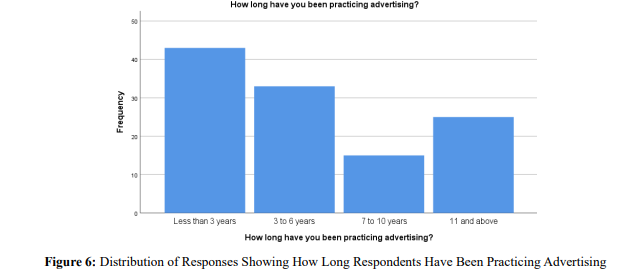
The result in figure 5 above shows that majority of the respondents 43 (out of 122) has less than 3 years of experience in advertising practice and they ranked highest. This is closely followed by respondents that had between 3 to 6 years of experience in advertising business as affirmed by 33 (out of 122) respondents and they ranked second. Respondents with eleven years experience in the advertising business ranked third from the result as affirmed by 25 (out of 122) respondents. At the bottom of the chart are respondents with between 7 to 10 years of experience
in the advertising business. This is affirmed by 15 (out of 122) respondents. The implication of these results is that most responses on awareness, perception and use of the Internet of Things in advertising business in this study will come from advertising practitioners with fewer years of experience (i.e. less than 6 years of experience) than those with more experience (i.e. 7 years and above). This may not serve as a good basis for generalization of findings when compared with the entire result.
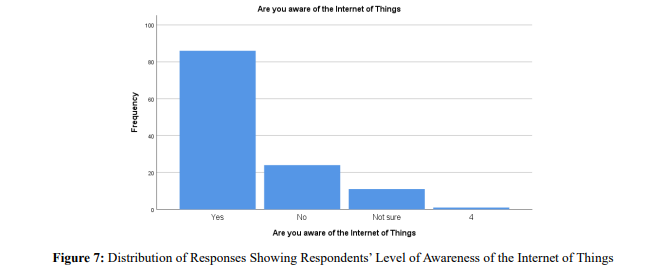
The result from figure 6 above which is on respondents’ level of awareness of the Internet of Things showed that majority of the respondents 86 (out of 122) are aware of the Internet of Things as against 25 (out of 122) respondents who are not aware of the Internet of Things. At the bottom of the chart are respondents who are not sure (11 out of 122) of being aware of the Internet of Thing. It may be they don’t really know what it means. The implication of this result is that most conclusions that will be drawn from the findings on level of awareness of Internet of Things in this study will be based on the opinion and attitude of those who are aware of the Internet of Things as affirmed by more than half of the respondents in this study. This can serve as a basis for generalization within the study group or individuals within the tertiary institution environment.
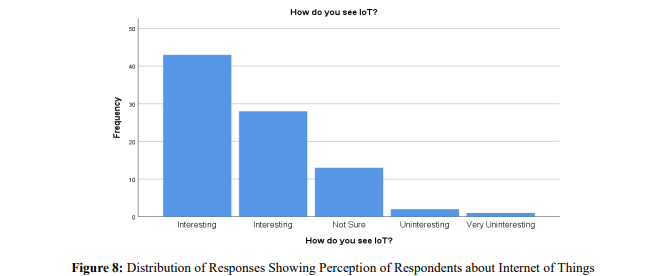
The result in figure 7 above revealed that most of the respondents 71 (out of 122) see Internet of Things as an Interesting technology tool in advertising business. This response may be attributed to respondents that are aware of the tool and how it works and must have had access to the tool. They ranked highest on the chart. On the other hand, respondents who are not sure of their perception of the Internet of Things (13 out of 122 respondents) ranked second from the result on the chart, leaving those who said that Internet of Thing is Uninteresting and Very Uninteresting at the bottom of the chart. This is affirmed by 2 and 1 respondents respectively (out of 122 respondents). The implication of this result is that positive perception of the Internet of Things can likely be traced to respondents who are aware of it and have had access to the technology. Also, the implication of the neutral perception (not sure) of the Internet of Things is traceable to respondents who are not aware of the Internet of Things and have not had access to it, hence, they are in doubt of giving their opinion on how they see the technology.
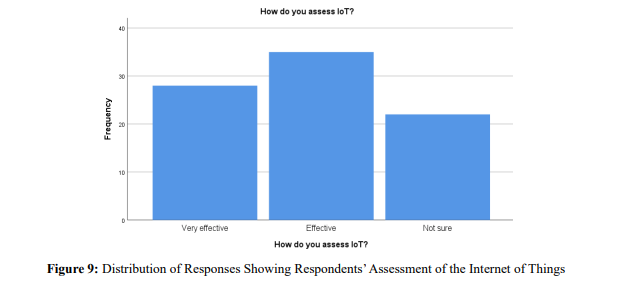 The result in figure 8 above showed that respondents that see the Internet of Things as being “effective” ranked highest with 35 (out of 122) while those that assess it as “very effective” ranked second on the chart as affirmed by 28 (out of 122) respondents. Hence, a total of 63 (out of 122) respondents assess the Internet of Things as a technology that has great impact in usage. On the other hand, 22 (out of 122) respondents are not sure of their assessment of the Internet of Things. This leaves them at the bottom of the chart on respondents’ assessment of the Internet of Things in advertising business. The implication of this result is that more positive perceptions and outcomes of the Internet of Things will come from only respondents who are not just aware of the technology but have had access to it and possibly used it to determine its effectiveness in advertising business.
The result in figure 8 above showed that respondents that see the Internet of Things as being “effective” ranked highest with 35 (out of 122) while those that assess it as “very effective” ranked second on the chart as affirmed by 28 (out of 122) respondents. Hence, a total of 63 (out of 122) respondents assess the Internet of Things as a technology that has great impact in usage. On the other hand, 22 (out of 122) respondents are not sure of their assessment of the Internet of Things. This leaves them at the bottom of the chart on respondents’ assessment of the Internet of Things in advertising business. The implication of this result is that more positive perceptions and outcomes of the Internet of Things will come from only respondents who are not just aware of the technology but have had access to it and possibly used it to determine its effectiveness in advertising business.
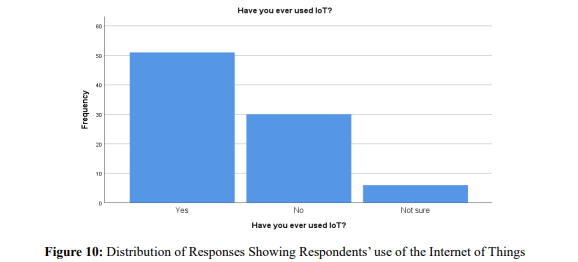
From the result in figure 9 above, less than half of the total respondents in the study (51 out of 122 respondents) have used the Internet of Things, and they ranked highest, while respondents who have not used the technology (30 out of 122 respondents) ranked second on the chart. At the bottom of the results in the chart are respondents who not sure or certain if they have used the Internet of Things. This is affirmed by 6 (out of 122 respondents). The implication of this result is that awareness of a given technology is not enough to determine positive perception. Also, only those have used a given technology can give correct assessment of that technology. Hence, in this study, there seem to be no correlation between usage of the Internet of Things and its assessment because the number of respondents that assessed as the technology as “very effective” and “effective” (i.e. 63 out of 122 respondents) are more than the number of respondents that have actually used the technology (i.e. 51 out of 122 respondents).
Individual assessment of the Internet of Things must have been informed by the various perceptions shared among respondents that have used the technology in advertising business and not necessarily respondents who are just aware of the technology but have not used it.
Discussion of Findings
In this section of the study, the findings were discussed in response to the objectives of the study and how they provided answers to either validate or reject the hypotheses proposed in the study. On the level of awareness of Internet of Things among advertising practitioners, the findings revealed that majority of male respondents between the ages of 26 – 35 years most of whom are in their tertiary level of education and are advertising practitioners are aware of Internet of Things technology. The implication of this findings is that their level of awareness were largely influenced by how long they have been in the advertising business. This goes to show that the length of years of practice enhances one’s opportunity of becoming aware of a given technology within the area of practice. Further demographic findings from this study revealed that the length of years of awareness of the Internet of Things technology among the respondents was found more on 6 years and below. This may be as a result of the extent to which they used devices that are linked with Internet of Things. Findings from the results on respondents’ perception of the Internet of Things technology revealed that there was a preponderance of positive perception of the technology as most of the respondents see it as an “interesting technology” in advertising business. Tracing this to the findings on level of awareness, there is a correlation between the length of years of awareness and one’s predisposition to assessing the technology based on its usefulness. Further findings on respondents’ assessment of the Internet of Things technology revealed that most respondents found it to be both “effective” and “very effective”. This was affirmed by more than half of the entire respondents within the study. The implication of this finding is that one’s assessment of a given technology is predetermined by how often one has access to the technology. This was accentuated in the study by more than half of the respondents having access to the Internet of Things technology. This further underscores the credibility of their assessment and perception of the given technology. Lastly, findings on the frequency of usage of the Internet of Things technology among respondents in the study revealed that though more than half of the respondents used the technology, their frequency of usage varied from one person to another. The preponderance of frequency of usage of the Internet of Things were found among respondents between the ages of 26 – 35 years who are mostly males and are in their tertiary level of education. Scholars believe that most individuals in their tertiary level of education are more internet savvy than those who are not. (Ani, et. al., 2017; Ukonu et. al. 2016; Shehu, et. al., 2015). This farther corroborates the findings in this study and underscores the relationship between frequency of usage of a given technology and one’s positive perception and assessment of the given technology. The findings from the test of hypotheses in this study further agrees with the earlier findings from the descriptive analysis results. Findings from the hypothesis result showed that differences in age of respondents does not significantly affect their level of awareness of the Internet of Things technology. Though findings from descriptive analysis showed that more males between the ages of 26 – 35 are aware and also adopt the technology. The implication of this findings is that awareness does not depend on age but on one’s need for a given technology and one’s level of education. Further findings from the hypothesis result revealed that gender does not significantly affect usage of Internet of Things. The implication here is that differences in gender is not a predetermining factor
for one’s usage of a given technology. Lastly, findings from the third hypothesis result revealed that age of respondents does not significantly affect the frequency of usage of Internet of Things in advertising business. The implication of this result is that one’s age has nothing to do with how often one uses a given technology. There are other factors that can enhance one’s frequency of usage of a given technology like one’s need or predisposition to using the technology as found by Ani, et. al. (2017) in their study on online shopping among tertiary institution students.
Conclusion and Recommendations
Our day – to – day activities are largely influenced by the penetration of technology and its interconnection with most of our devices. This trend of interconnection between devices has become a global phenomenon in technology development. One’s level of awareness, perception and use of Internet of Things as one of such technologies has been investigated in this study especially as it is found among advertising practitioners in the advertising business. The results of the data analyzed in this study gave rise to the findings and its resulting implications based on the objectives of the study. Though demographic variables were found not to significantly affect awareness, perception and frequency of use of Internet of Things but one can infer from the study that length of time of accessing a given technology and length of years of using same technology can influence one’s perception of such technology. Based on the above information, advertising practitioners can leverage on constant exposure to new technologies and applying its use within the purview of their practice. This will open up new horizons towards exploring the varying opportunities that abound with the use of such technology like Internet of Things in improving the way advertising business is done in this digital technology era [12-15].
References
1. Vermesan, O., & Friess, P. (2014). Internet of things applications-from research and innovation to market deployment (p. 364). Taylor & Francis.
2. Okorie, G. N., Udeh, C. A., Adaga, E. M., DaraOjimba, O. D., & Oriekhoe, O. I. (2024). Digital marketing in the age of iot: A review of trends and impacts. International Journal of Management & Entrepreneurship Research, 6(1), 104-131.
3. Lo, F. Y., & Campos, N. (2018). Blending Internet- of-Things (IoT) solutions into relationship marketing strategies. Technological Forecasting and Social Change, 137, 10-18.
4. Maier, M. V. (2016). The Internet of Things (IoT): what is the potential of Internet of Things applications for consumer marketing? (Bachelor's thesis, University of Twente).
5. Singh, S. THE CONVERGENCE OF MASS COMMUNICATION AND INTERNET OF THINGS (IOT): OPPORTUNITIES, CHALLENGES, AND IMPLICATIONS.
6. Amodu, L., Omojola, O., Okorie, N., Adeyeye, B., & Adesina, E. (2019). Potentials of Internet of Things for effective public relations activities: Are professionals ready?. Cogent Business & Management, 6(1), 1683951.
7. Maras, M. H., & Wandt, A. S. (2019). Enabling mass surveillance: data aggregation in the age of big data and the Internet of Things. Journal of Cyber Policy, 4(2), 160-177.
8. Dou, Z., Sun, Y., Wu, Z., Wang, T., Fan, S., & Zhang, Y. (2021). The architecture of mass customization-social internet of things system: Current research profile. ISPRS International Journal of Geo-Information, 10(10), 653.
9. Valentinetti, D., & Muñoz, F. F. (2021). Internet of things: Emerging impacts on digital reporting. Journal of Business Research, 131, 549-562.
10. Folarin, B. (1998). Theories of mass communication. Stirling- Horden Publishers.
11. Em, G., Ledbetter, A., & Sparks, G. (2012). A first look at communication theory. New York: McGraw HillCopanies.
12. Guo, B., Yu, Z., Zhou, X., & Zhang, D. (2012, May). Opportunistic IoT: Exploring the social side of the internet of things. In Proceedings of the 2012 IEEE 16th International Conference on Computer Supported Cooperative Work in Design (CSCWD) (pp. 925-929). IEEE.
13. Xu, M. (2022). [Retracted] The Combination of Internet of Things Technology Based on Probability Model Network and Mass Education. Wireless Communications and Mobile Computing, 2022(1), 2782473.
14. Venu, D. N., Arun Kumar, A., & Vaigandla, K. K. (2022). Review of internet of things (iot) for future generation wireless communications. International Journal for Modern Trends in Science and Technology, 8(03), 01-08.
15. Butkowski, C., Chan, N. K., Berniker, T., Rodriguez, A., Schlather, K., Max Zhang, K., & Humphreys, L. (2023). Communication about sensors and communication through sensors: localizing the Internet of Things in rural communities. Journal of Computer-Mediated Communication, 28(5), zmad005.


